HAND-FORGED KHUKURIS BY THE FINEST CRAFTSMEN IN NEPAL
* History of the Khukuri
* Origin of the word 'khukuri'
* Some information about Nepal
|
HIMALAYAN IMPORTS
HAND-FORGED KHUKURIS BY THE FINEST CRAFTSMEN IN NEPAL |
| CONTENTS * History of the Khukuri * Origin of the word 'khukuri' * Some information about Nepal |
|
Some history of the khukuri Rawson, in The Indian Sword, writes: 'The direct ancestor of the Kukri was no doubt the sword with a Kopis blade, but in the blades of certain Kukris it is clear that the conception of the forward angled blade, not the pure Kopis, underlies the form [see below picture 'Kopis-blade forms of the Indian subcontinent']. It is probable that the forward-angled form [which includes the indigenous Nepalese Kora] represents the oldest stratum over which the Rajput Kopis-bladed sword was superimposed' (pg. 52). **** The Gurkhas, more than anything else, have brought the khukuri to the attention of the world. For centuries this blade-form lay dormant in the world, being kept alive only in India and Nepal. And then the Gurkhas appeared on the world scene a couple of hundred years ago and brought with them their traditional weapon, the khukuri. Because the Gurkhas were probably the best mercenary force the world has ever seen--and may ever see--part of their fame became the fame of the khukuri. The word 'Gurkha' originates from King Prithvi Narayan Shah's 'Gorkhali' army (from the area of Gorkha, Nepal-northwest of Kathmandu), with whose help the King united Nepal into a single country between 1768-9 A.D. Nepal's present King, HM King Gyanendra Bir Bikram Shah Dev, descends from Prithvi Naryan Shah.Gorkha was feudal hill village in what is now western Nepal, however the 'Gorkhali' under Prithwi Narayan Shah and his successors grew so powerful that they overran the whole of the hill country from the Kashmir border in the west to kingdom of Bhutan in the east. Eventually, as a result of boundary disputes and repeated raids by Gurkha columns into British East India Company territory, the British Governor General declared war on Nepal in 1814. After two long and bloody campaigns a Peace Treaty was signed at Sugauli in 1816. During the war a deep feeling of mutual respect and admiration developed between the British and the Gurkhas, both sides being much impressed by the bravery, courage and decency of the other. Six hundred Gorkhas at Dehra Dun successfully held the fort of Kalanga against an English force of about 3500 under General Gillespie until the battering train was brought from Delhi; at the stockade at Tamta, the Gorkhas fought effectively with koras, described by the opposing British as being 'like the Highlanders of old, after discharging their matchlocks, rush[ing] in fierce through disorderly masses upon their opponents' (Mill, pg. 25). In the extremely bitter defence of the hill fortress of Kalunga the
Gorkhas lost 520 out of 600 defenders but they fought so bravely and so well
and the losses they inflicted on the British were so staggering it inspired
the British to erect a stone battle monument at Kalunga inscribed with the
words: THEY FOUGHT IN THEIR CONFLICT LIKE MEN AND, IN THE
INTERVALS OF ACTUAL CONFLICT, SHOWED US A LIBERAL COURTESY.
The Gorkhas too were impressed by their erstwhile
enemy, the British. Lieutenant Frederick Young leading a party of irregulars
was surprised by a force of Gorkhas. The irregulars, upon seeing the khukuri-wielding
Gorkha force, ran away, leaving the British officers to face the Gorkhas
alone. The ensuing battle was brief, but the British fought hard to hold
their ground until finally being forced to surrender. According to legend,
when asked why he had not fled as well, Young replied, 'I have not come so
far to run away. I came to stay.' And stay he did. For about a year the Gorkhas
held Young captive but during this year the Gorkhas developed a sincere
and deep respect for Young and the British fighting spirit which much resembled
their own. And, indeed, it was Young himself who was able to recruit the
first Gorkhas to serve under the British flag -- 3,000 Gorkhas divided into
four battalions. Young went on to serve as the commander of the Sirmoor
Battalion of Gurkhas for 28 years and, amazingly, was able to report his
battalion service ready after only six months.
Under the terms of the Peace Treaty large numbers of Gurkhas were permitted to volunteer for service in the East India Company's Army. From these volunteers were formed the first regiments of the Gurkha Brigade, and the basis of Britain's friendship with Nepal, which has continued to this day. These were the first Gorkhas, fighting men from the mountain kingdom of Nepal -- Rai, Magar, Limbu, Gurung and Sunwar tribesmen. Small of stature, large of heart, accustomed to hardship, good natured with a keen sense of humour, loyal to death, more disciplined than any fighting force in the world, brave and capable, and absolutely without fear.And the khukuri has always formed part of the gear of the Gurkha soldier--the 'kookrie' is mentioned as being an 'official piece of equipment' as early as 1837. The mere sight of these small hillmen with their distinctive blades has more than once put an enemy to flight and quelled riots without bloodshed. *****
The khukuri however is far more than just a jawan's
weapon :- in the hands of Nepal's large rural population
the khukuri is a knife-of-all-work,
serving to chop wood, slice vegetables, skin animals, cut
grass and is also used in Hindu religious ceremonies. And
almost everything about the khukuri means something: Colonel Kirkpatrick, said to have been the first Englishman to visit Nepal in 1793, wrote in praise of the khukuri: 'It is in felling small trees or shrubs, and lopping the branches of others for this purpose, that the dagger, or knife worn by every Nepaulian, and called Khookheri [sic], is chiefly employed; it is also of very great use, as I repeatedly experienced, in clearing away the road when obstructed by the low hanging boughs of trees, and other similar impediments' (Kirkpatrick, pg. 118). Indeed, the khukuri is a superior blade, both as a combat
weapon and as a tool. The unique shape of the khukuri makes it excellent
both for chopping wood and for hacking through dense jungles and forests
- serving as a combination of an axe and a machete - and anything else
requiring a good knife. This makes it a particularly ideal item for the
outdoorsman, hunter, hiker or explorer--or anyone who needs a rugged multi-functional
blade. for in-depth history and studies of the khukuri see further: J. Powell's The Kukri References * John Powell tells me that the 'blood-groove', though sometimes referred to as a 'Sword of Shiva' (on the HI forum & Khukuri FAQ), is not called by this name in Nepal. Terms used include: 'pwankh (the 'feather'), rato karang ('red rib'...from when they used lac to highlight a design rather than using a real fuller), aunlo bal ('finger of strength/force/energy') and others I couldn't even get them to translate' (J. Powell, personal communication). |
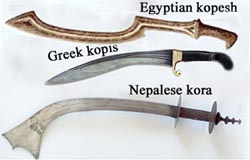
Origins of the khukuri? John Powell's Kukri articles 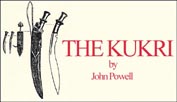 
19th-c. kukri given to Kami Sherpa 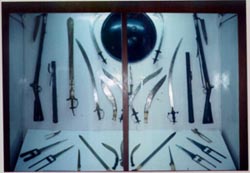
khukuris in Nepal's national museum more historical khukuris at H. Wallace's Khukuri FAQ page 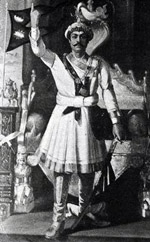
From Chandragiri's top I asked, 'Which is Nepal?' They showed me, saying 'That is Bhadgaon, that is Patan and there lies Kathmandu'. The thought came to my heart that if I might be king of these three cities, why, let it be so. --Raja Prithvinarayan Shah, 1st King of Nepal A Tribute to the Late King of Nepal, Birendra Bir Bikram Shah Dev |
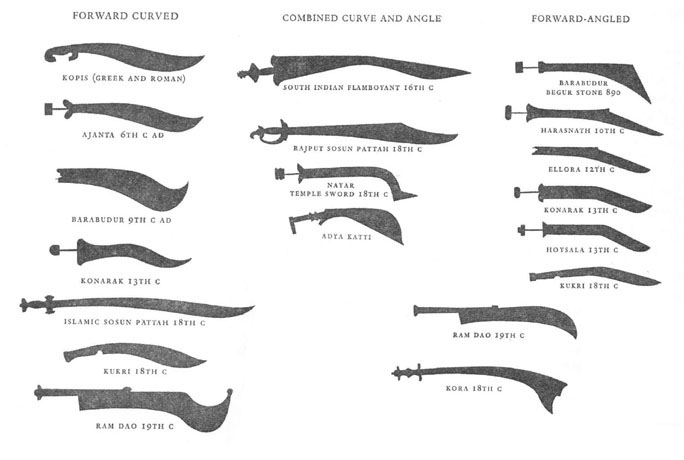
An etymological note on the word khukuri and related terms Though spelt various ways, the word khukuri --pronounced as koo-ka-ree with stress on the first syllable -- derives from Sanskrit kshura- 'razor' [(11)Turner-3727], cognate with Greek ksuron 'razor'. Sanskrit is an ancient Indo-European language (see chart below) in which the Hindu religions texts, such as the Vedas and Bhagavadgita, are preserved. The Nepali form khukuri shows (1) simplification of the initial cluster ksh to kh and (2) reduplication of the resulting root khur- to khukuri- (showing (3) loss of aspiration on the non-reduplicated part of the stem, presumably as part of Grassmann's rule which forbids two aspirated consonants to appear in a stem). The reduplicant (khu
The two usual accompanying tools of the khukuri are the small utility knife called the karda ( < Hindi kard < Persian [(10)Turner-pg.78])and the sharpening steel called chakma, chakmak ( < Hindi chaqmaq < Turkish [(10)Turner-pg.163]). --B. Slade References (1) Acharya, Jayaraj. A descriptive grammar of Nepali and an analyzed corpus. Washington, D.C.: Georgetown University Press, 1991. (2) Apte, Vaman Shivram. The student's Sanskrit-English dictionary. Poona, 1890. reprinted, Delhi: Motilal Banarsidass, 1973. (3) Bloch, Jules. Indo-Aryan: from the Vedas to modern times. English edition - largely revised by the author and translated by Alfred Master. Paris: Librairie d'Amérique et d'Orient, 1965. (4) Burrow, T. The Sanskrit Language. London: Faber and Faber, 1959 [2nd rev. ed., 1965]. (5) Grassmann, Hermann. 'Ueber die Aspiraten und ihr gleichzeitiges Vorhandensein im An- und Auslaute der Wurzeln'. Zeitschrift für vergleichende Sprachforschung auf dem Gebiete des Deutschen, Griechischen und Lateinischen 12.2 (1863): 81-138. (6) Masica, Colin P. The Indo-Aryan languages. Cambridge: Cambridge University Press, 1991. (7) Matthews, David J. A course in Nepali. London: School of Oriental & African Studies, 1984 (2nd ed., 1991). [reprinted, London: Curzon, 1998] (8) Monier-Williams, Sir Monier (with the collaboration of E. Leumann & C. Cappeller, et al.) A Sanskrit-English Dictionary: etymologically and philologically arranged with special reference to cognate Indo-European languages. Oxford: Oxford University Press, 1899-new ed. (earlier edition, 1872). [reprinted with corrections, Delhi: Motilal Banarsidass, 2002] (9) Schmidt, Ruth Laila with Ballabh Mani Dahal, et al. A Practical Dictionary of Modern Nepali / vyaavahaarika nepaalii-angrejii shabdakosh. Delhi: Ratna Sagar, 1993. (10) Srivastava, Dayanand. Nepali Language - its history and development. Calcutta: Calcutta University Press, 1962. (11) Turner, Sir Ralph Lilley. A comparative and etymological dictionary of the Nepali language. London: K. Paul, 1931. (reprinted, New Delhi: Allied Publisher, 1980) [online version available from Digital Dictionaries of South Asia, University of Chicago: http://dsal.uchicago.edu/dictionaries/turner/]. (12) Turner, Sir Ralph Lilley. A comparative dictionary of the Indo-Aryan Languages. 4 vols. London: Oxford University Press, 1966-1985. reprinted, Delhi: Motilal Banarsidass, 1999. (13) Vidyamahavaridhi, Parasamashi Pradyaan, & Nagebdramashi Pradyaan Samkalit. Thuulo nepaalii-nepaalii-angrejii kosh: Nepali-Nepali-English Dictionary. Kalimpong (West Bengal, India): Magyamani Prakashan, 1983. (14) Yadava, Yogendra P. & Warren W. Glover (eds.) Topics in Nepalese Linguistics. Kathmandu: Royal Nepal Academy, 1999. |

'khukuri' written in Nepali |

nb: this is not an exhaustive
listing of Indo-European languages or sub-families-
some languages and sub-famlies are omitted due to considerations of space |
|
Nepal and the Nepalis The Kingdom of Nepal lies between the east meridians of 80°22' and 88°12' and the north parallels of 26°22' and 30°27', bordered by India on the west, south and east, and by the Tibetan region of the People's Republic of China in the north. Nepal occupies an area of 54,718 square miles (88,041 km) and has a population of about 17 million. Mt. Everest (called Sagarmatha in Nepali), the highest mountain in the world (29,028 feet - 8848 metres), is located in the northern part of Nepal, and part of the Ganges plain is included in the south. In the Himalayan highlands of Nepal live Mongoloid peoples speaking Tibetan and other Tibeto-Burman languages, like the Sherpas. In the valleys of the lower Himalayas (like the Kathmandu & Pokhara valleys) reside various Indo-Aryan and Tibeto-Burman speaking peoples. South of the forest/jungle areas of the inner Terai, in the fertile flatlands of the Terai on the north edge of the Gangetic plain, there live a large percentage of Nepal's population - mainly Indo-Aryan speaking people. These flatlands are the most agriculturally productive part of Nepal and thus is one of the most economically important regions. ****
The earliest known history of Nepal begins with the
Kiratis, who seem to have arrived in Nepal from the east in the 8th or 7th
century BC. They are said to have favoured long knives (which may be an ancestor
of the khukuri). Later Buddhism spread into Nepal from India during
the Kirati era, but by 200 AD Hinduism had largely supplanted Buddhism. Hinduism
was introduced into the kingdom when the Licchavis, from northern India, invaded
and overthrew the Kirati ruler. By the late 9th-c. the Licchavi dynasty
had died out and had been replaced by that of the Thakuri. Later, from the
14th-18th centuries, a Newari royal family, the Mallas, ruled the Kathmandu
Valley.
Then, in the 18th-century, the ruler of Gorkha (in central Nepal, about 100km west of Kathmandu), King Prithvi Narayan Shah, conquered various warring principalities (most importantly in the Kathmandu Valley) and formed a united Nepal, founding the modern state of Nepal. Prithvi Narayan died in 1775 and was succeeded by his son Bahadur Shah, who continued to pursue a policy of expansion. By 1810 Nepal was twice its present size and its encroachment on the terrority of British India lead to the first and only Anglo-Nepali war during 1814-1816. Factionalism and intercine fighting amongst Prithvi Narayan's descendents lead to the Kot Massacre in 1846, during which General Jung Bahadur Rana seized power of the government and had himself proclaimed Prime Minister for life as well as assuming the title Maharajah. The rightful royal family of Nepal, the Shahs, were reduced to virtual figureheads and cyphers. Relations with British India were improved when Jung Bahadur assisted in quelling the Sepoy Rebellion (Indian Mutiny) of 1857 with Gurkha troops. When Britain withdrew from India in 1947-8, the support of the Rana government was weakened. In 1950, King Tribhuvan fled to India and later lead in the democratic movement of the Nepali Congress Party and B.P. Koirala against the Rana government. A system of 'Panchayat' democracy was established, under which political parties were not allowed. In 1989-90, the Nepali Congress Party with the support of the Communist Party of Nepal agitated against the 'panchayat' system; and, in 1991, a government was formed, headed by the Nepali Congress leader Krishna Prasad Bhattarai. In the late 1990s, a Maoist guerilla movement began rebelling against the government. Maoist attacks have claimed over 1700 lives thus far in Nepal, and disrupted the economy, partially through their dacoit style tactics. 2001 saw a royal massacre of many of the members of the royal family, including King Birendra Shah, by Crown Prince Dipendra. The late king's brother, Gyanendra ascended to the throne and quickly restored stability. ****
The founder of the modern state of Nepal, His Majesty
King Prithvi Narayan Shah, described Nepal over two centuries ago as 'a flower
garden of four castes and thirty-six tribes' (Yadava & Glover p. iii);
-- and to this description one may add '120 languages'. Bahuns (Brahmins)
rank highest in the traditional caste hierarchy, along with Chhetris (Kshatriyas)
they formed a majority of the influential and wealthy people of Nepal and
are the most widely dispersed throughout the country. More than half of all
Bahuns & Chhetris live in the western hills, where they are about 80%
of the area's total population. Their mother tongue, Nepali, an Indo-Aryan
language, has become the state language of Nepal. Nepali (also called Gorkhali,
Parbatiya, Khaskura) is also the mother tongue of a small number of occupational
castes, such as the Damai (tailors), Sarki (cobblers), Kami
(blacksmiths) and Sunar (goldsmith) castes (see Bista). About
58% of the population of Nepal speaks Nepali as their mother tongue. Other
prominent Indo-Aryan languages of Nepal include Awadhi (2%), Bhojpuri (7.5%),
Maithili (11.9%) and Tharu (5.3%). The majority of the other languages of
Nepal are Tibeto-Burman languages, including Gurung (1.23%), Limbu (1.37%),
Newari (3.73%) and Tamang (3.26%).
Many of the Gurkha troops are and were recruited from the (Mongoloid) hill tribes of Gurung, Magar, Limbu and Rai. 
Gorkhali Girl dancing References (1) Bista, Dor Bahadur. People of Nepal. Kathmandu: Ratna Pustak Bhandar, 1989 (7th ed., 2000). (2) Bonarjee, P.D. A Handbook of the Fighting Races of India. Calcutta: Thacker, Spink & Co., 1899. (3) Chaudhuri, Kiran Chandra. Anglo-Nepalese Relations: from the earliest times of the British rule in India till the Gurkha War. Calcutta: Modern Book Agency Private Ltd., 1960. (4) Hamilton, Francis Buchanan. An Account of the Kingdom of Nepal, and of the Territories Annexed to this Dominion by the House of Gorkha. Edinburgh: Archibald Hamilton, 1819. reprinted, New Delhi: Asian Educational Service, 1986. (5) Husain, Asad. British India's Relations with the Kingdom of Nepal 1857-1947: a diplomatic history of Nepal. London: George Allen & Unwin, 1970. (6) Kirkpatrick, Col. William. An Account of the Kingdom of Nepaul, being the Substance of Observations made During a Mission to that Country, in the Year 1793. London: William Miller, 1811. reprinted, New Delhi: Asian Educational Services, 1996. (7) Krauskopff, Gisèle and Pamela Deuel Meyer (eds.) with Tek Bahadur Shrestha, Kurt Meyer & Tej Panjiar. The Kings of Nepal & the Tharu of the Tarai. Los Angeles: rusca Press & Kirtipur (Nepal): Research Centre for Nepal and Asian Studies, Tribhuvan University, 2000. (8) Landon, Perceval. History of Nepal. 2 vols. London: Constable & Co., Ltd., 1923. reprinted, Delhi: Adarsh Enterprises, 2001. (9) Prithvinarayan Shah. Dibya Upadesh. Yogi Narhari Nath, ed. Kathmandu, 2016 B.S. (10) Rana, Lt. General Daman Shumsher Jang Bahadur. Nepal: rule and misrule. New Delhi: Rajesh Publications, 1978. (11) Rana, Pudma Jung Bahadur. Life of Maharaja Sir Jung Bahadur, G.C.B., G.C.S.I., etc., etc., of Nepal by his son the late General Pudma Jung Bahadur Rana. Abhay Charan Mukerji, ed. Allahabad (U.P., India): Pioneer Press, 1909. reprinted, Kathmandu: Ratna Pustak Bhandar, 1980 (Bibliotheca Himalayica II.8). (12) Singh, Sarva Daman. Ancient Indian Warfare: with special reference to the Vedic period. Leiden: Brill, 1965. [2nd ed., Delhi: Motilal Banarsidass, 1989. (13) Subba, T.B. "Being a Nepali in Northeast India: predicaments of a 'privileged nation'". in The Nepalis in Northeast India: a community in search of Indian identity. A.C. Sinha & T.B. Subba, eds. New Delhi: Indus, 2003: pp. 197-207. (14) Stiller, Ludwig F., S.J. The Rise of the House of Gorkha: a study in the unification of Nepal 1768-1816. Kathmandu: Patna Jesuit Society, 1973. (15) Thapa, Netra Bahadur. A Short History of Nepal. Kathmandu: Ratna Pustak Bhandar, 1967 [3rd. ed.]. (16) Tucci, Giuseppe. Nepal: the discovery of the Malla. trans. from Italian by Lovett Edwards. London: George Allen & Unwin, 1962. (17) Yadava, Yogendra & Warren W. Glover, eds. Topics in Nepalese Linguistics. Kathmandu: Royal Nepal Academy, 1999. |
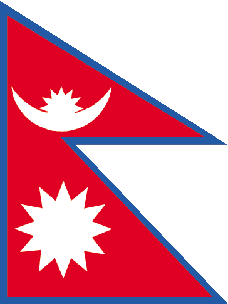
Brief History of Nepal [BBC] 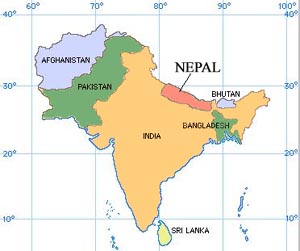
History of Nepal [countryreports.org] CIA World Factbook entry for 'Nepal' Nepali/Gurkhali Language Tutorial Online 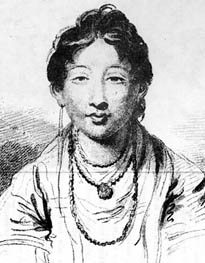
a woman of Nepal drawn by A.W. Devis, Esqr. taken from Kirkpatrick's An Account of the Kingdom of Nepaul Languages of Nepal (at Ethnologue.com) 
Tamang girl |
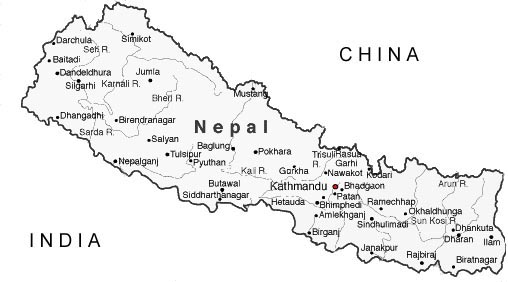
|
Some Nepal News Sites
(in English) Nepali Times Gorkha Patra Nepal News.com Kantipur Online Nepal News.net Newslook Magazine online CyberNepal Internet Magazine BBC News in Nepali (audio & print) |
|
Himalayan Imports
3495 Lakeside Dr. PMB 69 Reno, NV 89509 USA 775-825-2279 |
||
|
|
||
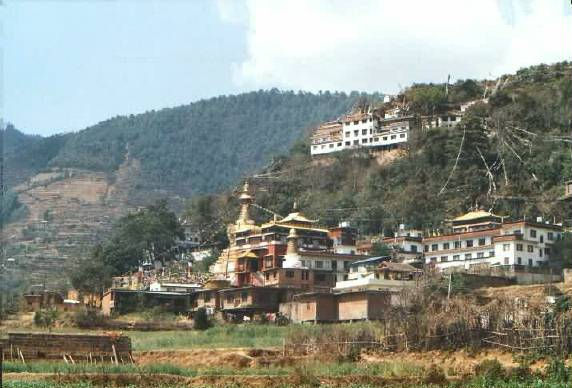
All content on this WebSite is copyright 2010, Himalayan Imports
Some disreputable firms have copied pictures of Himalayan Imports' products off our website, and have used them
in their own advertisements to pawn off lesser-quality khukuris on unsuspecting consumers!
Please inform us if you discover illicit use of our content.
Original site design by
Benjamin Slade
Daniel Koster
Bill Martino
w/ many suggestions from Himalayan Imports Cantina regulars